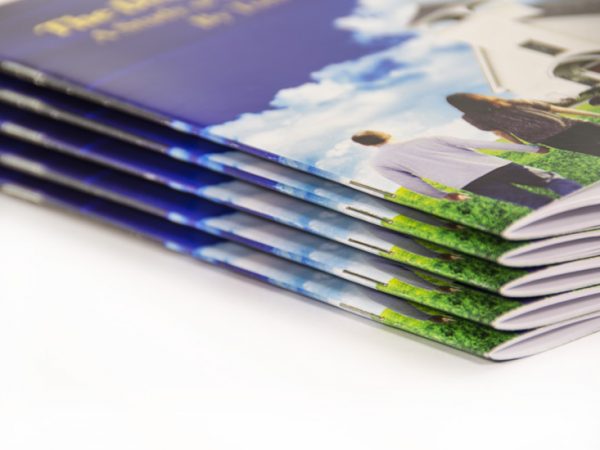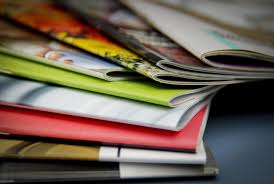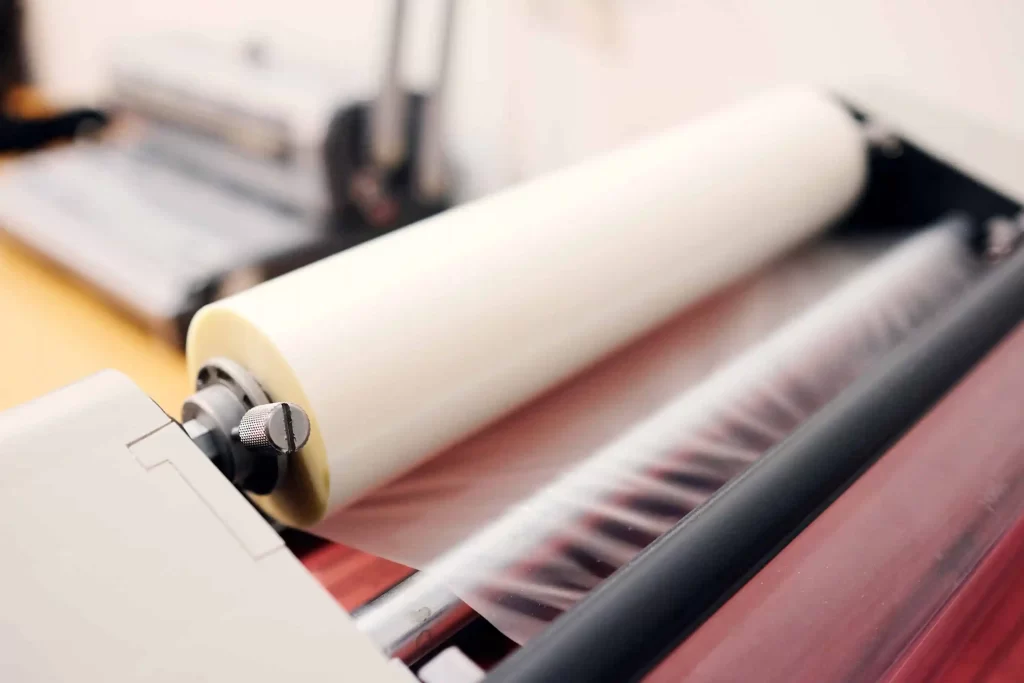
When it comes to creating saddle stitched booklets, selecting the right paper and finish is crucial for achieving a professional and visually appealing result. The right choice of paper stock and finish can make your booklets stand out and leave a lasting impression.
Not only do you want your saddle stitched booklets to look good, but you also want them to feel good in the hands of your readers. By choosing the right paper and finish, you can give your booklets a polished and professional appearance that reflects positively on your brand or business.
In this article, we will guide you through the process of choosing the perfect paper stock and finish for your saddle stitched booklets. From understanding the basics of saddle stitch booklet printing to selecting the ideal paper weight and opacity, we’ll cover all the essential information you need to know.
Key Takeaways:
- Choosing the right paper and finish is crucial for achieving a professional appearance when printing booklets.
- Understanding the basics of saddle stitch booklet printing and choosing the right size and orientation is important.
- Consider different paper stocks such as laser paper, uncoated paper, and satin paper for various effects.
- Explore different paper finishing options like glossy, matte, and uncoated finishes to enhance your booklet’s appearance.
- Pay attention to paper weight and opacity to ensure durability and overall quality.
Understanding the Basics of Saddle Stitch Booklet Printing
Saddle stitching is a popular binding method within a printing process used for creating booklets. It involves folding a stack of pages in half, aligning them, and then stapling them together at the fold. This simple yet effective technique creates a secure and durable booklet that is easy to flip through.
What is Saddle Stitching?
Saddle stitching is a bookbinding method that involves using staples to secure the pages of a booklet at the center fold. It is commonly used for booklets, brochures, magazines, catalogs, and other publications with a small number of pages.
Different Sizes and Orientations for Saddle Stitched Booklets
Saddle stitched booklets are available in different sizes and orientations to suit various printing needs. The most commonly used sizes include A5 and A4 booklets, but small booklets including DL and A6 are also viable.
Choosing Between A5 and A4 Booklets
A5 booklets, also known as half-letter booklets, have dimensions of 148 x 210 mm (5.8 x 8.3 inches) when closed. They are compact and portable, making them suitable for brochures, event programs, and smaller booklets.
A4 booklets are larger, with dimensions of 210 x 297 mm (8.3 x 11.7 inches) when closed. They provide more space for content and are often used for product catalogs, company profiles, and manuals where detailed information is required.
Opting for the Right Paper Stock
The choice of paper stock plays a significant role in the overall look and feel of your saddle stitched booklet. Here are some options to consider:
100GSM Laser Paper Stock for a Sleek Look
When you want your booklet to exude a sleek and professional appearance, consider using 100GSM laser paper stock. This type of paper is known for its smooth texture and high-quality finish, allowing for crisp and vibrant printing of images and text.
140GSM Uncoated Paper Stock for Menus and Promotions
If you’re creating booklets for menus or promotional materials, 140GSM uncoated paper stock is an excellent choice. Uncoated paper has a matte texture that gives a more natural and rustic look to your booklet. It is perfect for showcasing menus, product catalogs, or event programs.
150GSM Satin Paper Stock for Added Durability
When durability is a key factor for your booklets, opt for 150GSM satin paper stock. Satin paper offers a smooth and lustrous finish, providing enhanced protection against wear and tear. It is ideal for booklets that will be frequently handled or used for extended periods. Great for promotional brochures and exhibition catalogues.
| Paper Stock | Weight (GSM) | Finish | Best Use |
|---|---|---|---|
| 100GSM Laser Paper Stock | 100 | Sleek | Professional booklets |
| 140GSM Uncoated Paper Stock | 140 | Matte | Menus, promotions |
| 150GSM Satin Paper Stock | 150 | Lustrous | Durable booklets |
The Significance of Paper Finishing in Saddle Stitched Booklets

Paper finishing options play a crucial role in enhancing the overall appearance and tactile experience of your saddle stitched booklets. The choice of finish can greatly impact the way your booklet looks and feels, allowing you to create a customized and professional finish that stands out. Whether you want a glossy, matte, or uncoated finish, there are several options to consider.
Here are some common paper finishing options that can enhance the appearance of your saddle stitched booklets:
- Glossy Finish: A glossy finish offers a high-shine, reflective surface that adds a touch of sophistication to your booklets. It provides vibrant colors and sharp images, making your booklet visually captivating.
- Matte Finish: If you prefer a more subtle and elegant look, a matte finish is an excellent choice. It offers a smooth, non-glossy surface that reduces glare and provides a sophisticated touch.
- Uncoated Finish: An uncoated finish gives your booklet a natural and tactile feel. It provides a soft texture and allows for better writability, giving your readers a personal and engaging experience.
By choosing the right paper finishing option, you can enhance the overall appearance of your saddle stitched booklets and create a lasting impression on your readers.
| Finish | Description | Benefits |
|---|---|---|
| Glossy | A high-shine, reflective surface | Enhanced visual appeal, vibrant colors, sharp images |
| Matte | A non-glossy, subtle surface | Elegant and sophisticated look, reduced glare |
| Uncoated | Natural and tactile texture | Soft feel, better writability |
Selecting the Ideal Paper Weight and Opacity
There are key considerations to keep in mind when selecting the paper weight and opacity for your saddle stitched booklet. These factors play a crucial role in determining the durability and overall quality of the final product. Let’s explore the following points:
When to Choose Heavier Paper Weights
Choosing the appropriate paper weight depends on the purpose and desired impact of your booklet. Heavier paper weights are ideal for booklets that need to withstand frequent handling or have a longer lifespan. They provide a more substantial feel and increased durability, making them suitable for high-end catalogs or premium publications. Consider using heavier paper weights for important documents or booklets that will be used extensively.
Understanding Opacity for Printed Pages
Opacity refers to the degree to which paper allows light to pass through. Higher opacity paper ensures minimal show-through, making it an excellent choice for double-sided printing. This is especially important when you have content on both sides of each page in your saddle stitched booklet. Opting for higher opacity paper enhances the readability and overall appearance of your printed pages. It helps maintain a professional finish and prevents unwanted ink or text visibility from the reverse side.
To help you better understand the relationship between paper weight and opacity, refer to the following table:
| Paper Weight | Opacity |
|---|---|
| 75GSM | Low |
| 100GSM | Medium |
| 120GSM | High |
| 150GSM | Very High |
As you can see, selecting a higher GSM (grams per square meter) paper weight often correlates with increased opacity. However, it’s essential to strike a balance between weight, opacity, and your intended design aesthetic to achieve the desired result.
By carefully considering the ideal paper weight and opacity for your saddle stitched booklet, you can ensure its durability, readability, and overall quality. Choosing a heavier paper weight and higher opacity will contribute to a professional appearance and enhance the visual impact of your printed pages.
Continue reading: Design Considerations for Professional Saddle Stitched Booklets.
Design Considerations for Professional Saddle Stitched Booklets

Creating a visually captivating and professional saddle stitched booklet involves careful consideration of design elements. Two key factors to focus on are the importance of high-resolution images and maintaining brand consistency through design.
Importance of High-Resolution Images
High-resolution images are essential for achieving a polished and professional appearance in your saddle stitched booklets. When selecting images, make sure they have sufficient resolution (at least 300 dpi) to ensure crisp and clear printing. High-resolution images enhance the overall visual impact of your booklets, conveying professionalism and attention to detail.
Maintaining Brand Consistency Through Design
Consistency is key when it comes to reinforcing your brand identity. Pay close attention to the design elements you incorporate in your saddle stitched booklets to ensure they align with your brand guidelines. Consistent use of colors, fonts, and imagery enhances brand recognition and creates a cohesive and professional booklet design.
Remember to consider the following design considerations when creating your saddle stitched booklets:
- Choose fonts that reflect your brand’s personality and are easy to read.
- Balance text and images to create an aesthetically pleasing layout.
- Use white space strategically to increase readability and draw attention to key elements of the product.
- Select colors that complement your brand and evoke the desired emotional response.
- Ensure proper alignment and spacing throughout the design to create a polished look.
| Design Consideration | Description |
|---|---|
| Font Selection | Choose fonts that reflect your brand’s personality and are easy to read. |
| Balance of Text and Images | Create an aesthetically pleasing layout by balancing text and images. |
| Effective Use of White Space | Strategically use white space to increase readability and draw attention to your key elements. |
| Color Palette | Select colors that complement your brand and evoke the desired emotional response. |
| Proper Alignment and Spacing | Ensure elements are properly aligned and spaced to create a polished look. |
By considering these design elements and adhering to brand guidelines, you can create professional saddle stitched booklets that effectively convey your message and leave a lasting impression on your audience.
Saddle Stitched Books: Binding Options and the Role of Page Count

Saddle stitched booklets provide a versatile and cost-effective binding option for various printing needs. This method involves folding the pages in half and stapling them together at the fold. It is commonly used for booklets with relatively low page counts, typically ranging from 8 to 48 pages. The page count must be in multiples of 4 to make the process tangible – often clients will add blank pages (typically inside front and back covers) to bring the books into like with this.
When considering the binding options for your saddle stitched booklets, it’s important to keep the page count in mind. The binding technique is most suitable for booklets with a smaller number of pages. If the page count exceeds the capacity of saddle stitching, alternative binding methods such as perfect binding or wire-o binding may be more appropriate.
It’s worth noting that page count plays a crucial role in the overall thickness of the booklet and impacts its appearance and usability. A higher page count may require a thicker paper stock to ensure durability and prevent the booklet from becoming too bulky.
When determining the page count for your saddle stitched booklet, consider the purpose and content of the booklet. If it’s meant to serve as a brochure or promotional material, a shorter page count may be sufficient. However, for informational booklets or catalogs, you may need more pages to accommodate all the necessary content.
By understanding the binding options and the role of page count, you can make informed decisions when designing and printing your saddle stitched booklets, ensuring they are well-suited to their intended purpose and provide a professional and visually appealing product.
Maximising Visual Impact with the Right Cover Options
The cover of your saddle stitched booklet is an opportunity to make a strong visual impact. It sets the tone for the content inside and can grab the attention of your readers. When it comes to cover options, there are two main choices: self cover and hard cover.
Difference Between Self Cover and Hard Cover Options
Self cover refers to using the same paper stock for the cover as the inside pages. This option provides a cohesive and unified look throughout the booklet. It is suitable for booklets with fewer pages and a simpler design. Self cover booklets offer a seamless visual experience and a sense of continuity.
On the other hand, hard cover booklets have a separate, thicker cover material that is more durable and sturdy. The hard cover adds a premium and professional touch to your booklet. It provides extra protection for the inner pages and gives the booklet a more substantial feel. Hard cover booklets are ideal for more extensive content and high-quality presentation.
Choosing Between Gloss, Matte, and Uncoated Finishes
Another crucial aspect of your saddle stitched booklet cover is the finish. There are three primary finish options to consider: gloss, matte, and uncoated.
- Gloss finish offers a shiny and reflective surface that enhances colors and adds a polished look. It gives your booklet a vibrant and eye-catching appearance, making it suitable for marketing materials, brochures, or event programs.
- Matte finish provides a non-reflective and smooth surface that gives your booklet a sophisticated and elegant look. It reduces glare and offers a more subtle and muted aesthetic. Matte finish is often chosen for professional reports, portfolios, or catalogs.
- Uncoated finish creates a natural and tactile feel, with a slight texture that adds depth to your booklet. It is commonly used for more informal or organic designs, such as journals, notebooks, or art books.
When selecting the right cover option and finish, consider the purpose, target audience, and desired visual impact of your saddle stitched booklet. By choosing wisely, you can create a visually stunning booklet that captivates readers and leaves a lasting impression.
Enhancing Your Booklet with Special Printing Features
Special printing features can take your saddle stitched booklet to the next level, enhancing both its visual appeal and functionality. Consider incorporating the following options to make your booklet stand out:
Adding UV Coating or Soft Touch Laminate

UV coating and soft touch laminate are two popular finishing options that can bring a touch of elegance and protection to your booklet. UV coating adds a glossy and reflective finish, making colors appear more vibrant and images more eye-catching. On the other hand, soft touch laminate provides a luxurious and velvety feel, creating a tactile experience that engages the reader.
Incorporating Custom Elements Like Three-Hole Punch
Custom elements like a three-hole punch can add functionality to your booklet, making it easier to organize and store. A three-hole punch allows you to insert the booklet into a binder or folder effortlessly, ensuring that important information is easily accessible. By incorporating custom elements, you can tailor your booklet to meet specific needs and make it more user-friendly.
How to Set Up Your Artwork for Saddle Stitched Booklet Printing
Proper artwork setup is crucial for achieving successful saddle stitched booklet printing. By following these tips, you can ensure that your artwork is print-ready, with the proper bleed and margin for binding.
Setting Up Print Ready Files
When preparing your artwork for saddle stitched booklet printing, it’s essential to create print-ready files. Here’s how to do it:
- Use a professional design software like Adobe InDesign or Illustrator to create your artwork.
- Set your document size to the final trim size of the booklet.
- Include a bleed area of at least 3mm on all sides of the document to allow for trimming.
- Ensure that all images and graphics are high-resolution and suitable for print.
- Convert all fonts to outlines to avoid any potential font issues.
- Save your file as a print-ready PDF, using the appropriate settings for professional printing.
Ensuring Proper Bleed and Margin for Binding
Proper bleed and margin are essential for saddle stitched booklet printing to ensure that no important elements are cut off during the trimming process and that the text remains legible after binding. Follow these guidelines:
- Set up a bleed area of 3mm on all sides of your document, extending any background colors or images beyond the trim edge.
- Keep important text and design elements at least 5mm away from the trim edge to prevent them from being cut off in the final product.
- Consider the placement of the binding. Leave an additional margin of at least 10mm on the side of your artwork that will be bound. This ensures that no important content or design elements will be lost in the binding process.
By following these tips, you can ensure that your artwork is properly set up for saddle stitched booklet printing, resulting in a professional and visually appealing end product.
Conclusion
In conclusion, choosing the right paper and finish for your saddle stitched booklets is crucial for achieving a professional and visually appealing result. By carefully considering factors such as paper stock, weight, opacity, design, and binding options, you can create booklets that are tailored to your specific needs.
When selecting paper stock, opt for options like 100GSM laser paper for a sleek look, 140GSM uncoated paper for menus and promotions, or 150GSM satin paper for added durability. These choices will enhance the overall appearance and tactile experience of your booklets.
Additionally, pay attention to design considerations such as using high-resolution images and maintaining brand consistency. These elements contribute to the professionalism and impact of your saddle stitched booklets.
By following these guidelines and considering the various options available, you can ensure that your saddle stitched booklets stand out and make a lasting impression. Invest in high-quality paper and finishes to create a professional product that reflects your brand’s identity and captures the attention of your target audience.
FAQ
What is saddle stitching?
Saddle stitching is a popular binding method for booklets that involves folding a stack of pages in half and stapling them with wire staples together at the fold.
What are the different sizes and orientations available for saddle stitched booklets?
Saddle stitched booklets ave an extensive range and can be printed in various sizes and orientations, including A5 and A4.
How do I choose between A5 and A4 booklets?
The choice between A5 and A4 booklets depends on factors such as the amount of content and the desired visual impact. A5 booklets are more compact, while A4 booklets offer larger page sizes for more detailed content.
What are the different paper stock options for saddle stitched booklets?
Some paper stock options for saddle stitched booklets include 100GSM laser paper for a sleek look, 140GSM uncoated paper for menus and promotions, and 150GSM satin paper for added durability.
How does paper finishing affect the appearance of saddle stitched booklets?
Paper finishing options, such as glossy, matte, and uncoated finishes, can significantly enhance the visual appeal and tactile experience of saddle stitched booklets.
What is the significance of paper weight and opacity in saddle stitched booklets?
The paper weight and opacity of saddle stitched booklets determine their durability and overall quality. Heavier paper weights are ideal for thicker booklets, and opacity affects the visibility of printed pages.
What are some design considerations for professional saddle stitched booklets?
High-resolution images and maintaining brand consistency are important design considerations for creating professional saddle stitched booklets.
What are the binding options for saddle stitched booklets?
Saddle stitched booklets are bound by folding the pages in half and stapling them together at the fold. The page count and binding method determine the thickness and durability of the booklet.
What are the cover options for saddle stitched booklets?
Saddle stitched booklets can have either a self cover, using the same paper stock as the inside pages, or a hard cover for added durability. Different finishes, such as gloss, matte, and uncoated, can be applied to the cover.
How can special printing features enhance saddle stitched booklets?
Special printing features like UV coating, soft touch laminate, and custom elements like three-hole punch can elevate the appearance and functionality of saddle stitched booklets.
How do I set up artwork for saddle stitched booklet printing?
Proper artwork setup involves creating print-ready files, ensuring proper bleed and margin for binding, and following the guidelines provided by the printing company.








